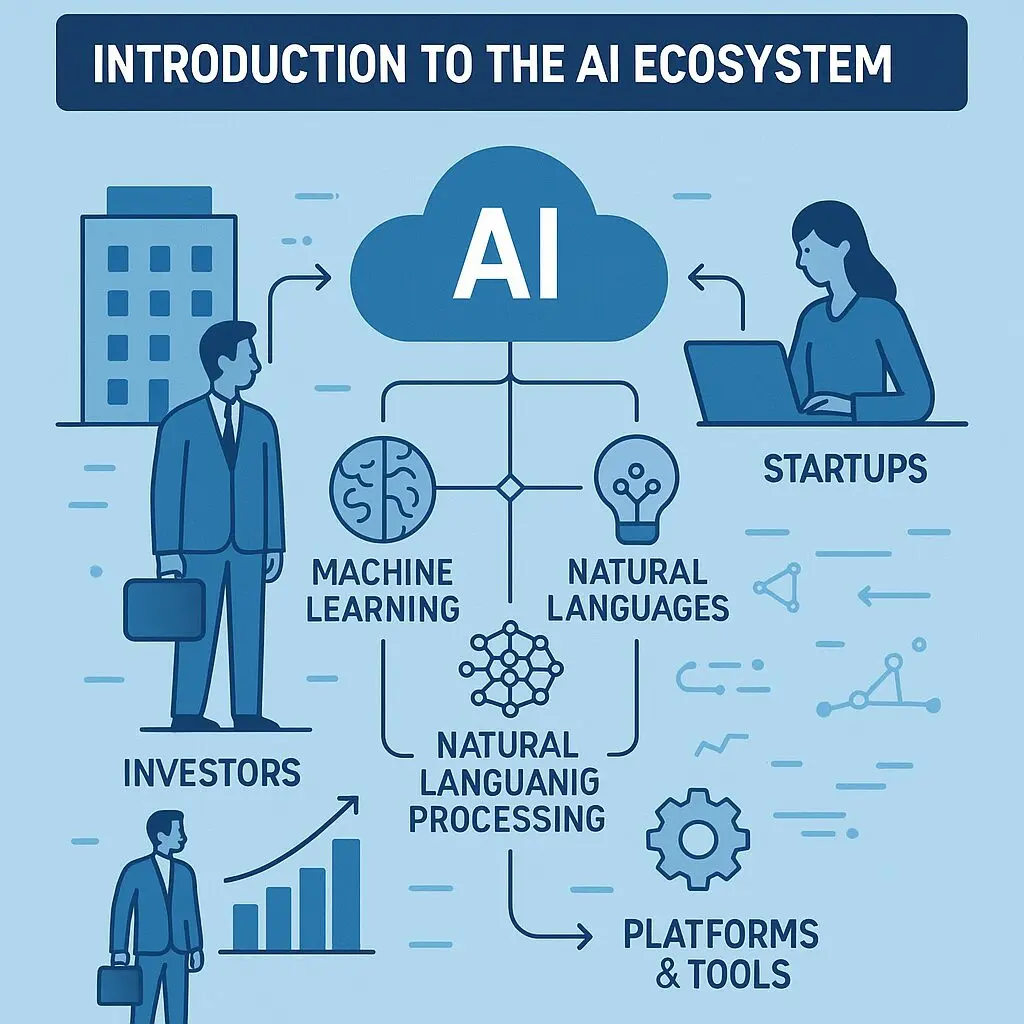In 2025, the U.S. startup landscape is undergoing a profound transformation as artificial intelligence reshapes not only how businesses operate but also the nature of the competition they face. As tech giants deploy cutting-edge AI models, up-and-coming startups are rising to the challenge—specializing in niche applications, leveraging open‑source tools, forming strategic partnerships, and securing record-level venture funding. Here’s a closer look at how they’re adapting and thriving.
1. 🎯 Niche Targeting: Specialization Over Scale
AI’s disruptive impact isn’t limited to general-purpose tools—it’s proliferating in specialized domains. Startups are increasingly focusing on vertical-specific problems that big tech giants overlook.
- Legal Tech Revolution: The LegalTech Lab accelerator supports AI-driven firms like Crosby and Eudia, which automate tasks such as contract drafting and legal research for SMBs
- Healthcare AI: Abridge, which uses AI to transcribe patient-clinician conversations, closed a $250 million Series D at a $2.75 billion valuation
- Other vertical leaders include Hippocratic AI (medical LLMs), Omneky (AI-generated ads), SoundHound (voice‑activated agents for enterprises), and Adept AI (desktop automation). These firms are dominating narrow niches with highly customized AI solutions
By focusing on narrow use cases, these startups sidestep direct competition with industry giants like Google, Microsoft, and OpenAI, while delivering tailored solutions that meet urgent industry needs
2. 🤝 Strategic Partnerships: Power Through Collaboration
Scaling AI operations requires formidable infrastructure—a hurdle for cash-strapped startups. To bridge this gap, many are partnering with larger players and tapping into regulatory support.
- Ecosystem-enabled growth: Startups are joining forces with corporates; e.g., Perygee integrates with PepsiCo and Burger King to enhance enterprise workflows
- Government-backed accelerators: LegalTech Lab and other programs offer support, advisory networks, and initial investment to spur early-stage AI innovation .
- Cloud and hardware alliances: Companies like OpenAI and Anthropic benefit from Microsoft, Google, and AWS investments, giving them access to top-tier compute. Meanwhile, startups such as Cohere and Ceramic.ai align with enterprise infrastructure offerings to stay competitive
Taken together, these collaborations allow startups to leverage ecosystems, scale faster, and avoid imposing full operational overhead too soon.
3. 💸 Venture Funding Boom: The AI Capital Surge
The AI startup universe is witnessing a frenzy of investment. U.S. AI startups have collectively raised over $150 billion in 2025, with nearly a dozen hitting $100 million+ rounds already
Notable mega-rounds:
- Anthropic: $3.5 billion, valuation $61.5 billion
- Lambda: $480 million for compute infrastructure
- Together AI: $305 million for generative AI infrastructure
- Abridge and Harvey: $250 million and $300 million rounds respectively for healthcare and legal tech
Even smaller seed-stage startups—like Ceramic.ai and Model ML—are drawing multi-million-dollar investments
VC firms such as Kleiner Perkins, Boldstart ($250 million fund), and a16z are leading the charge This capital is crucial—it enables startups to invest in talent, infrastructure, and product development, leveling the playing field with larger players.
4. 🧠 Hiring & Talent Wars: Paying the Premium
AI talent remains the most valuable—and contested—resource. Startups are competing directly with giants for engineers, researchers, and ML experts:
- Compensation premiums are soaring, sometimes reaching up to $200,000 above standard salaries
- Meta and other big tech firms are offering multi-million or even $100 million+ packages to lure top AI talent, reinforcing the competitive hiring landscape
- In this environment, early-stage startups are forced to offer apprenticeships, equity, and flexible remote arrangements to attract high-caliber hires.
This talent strain heavily influences startup go-to-market readiness and product timelines.

5. 🛠 Open Source & Infrastructure Leverage
Not every startup can build a proprietary LLM from scratch—so many are tapping open-source tools to build fast and lean:
- Together AI develops open-source generative AI infrastructure
- Ceramic.ai focuses on efficient long-LM training using open architectures .
- Other examples include Cohere (enterprise API models) and Ciroos (AI ops automation)
This open-source strategy saves development time and infrastructure costs, enabling startups to stay agile and innovative even without custom chips or vast compute resources.
6. 🧩 Regulatory and Antitrust Dimensions
As AI thrives, regulators are keeping a close eye on platform–startup relationships:
- The FTC is scrutinizing partnerships between cloud giants and major AI startups like OpenAI, Anthropic, and others
- Assistant-Attorney General Gail Slater is signaling proactive antitrust enforcement to preserve competition and prevent consolidation of AI power in the hands of Big Tech
While regulatory scrutiny may pose short-term obstacles, startups can benefit from policies that prevent market lock-in—even enabling smaller players to partner with dominant platforms without anti-competitive risk.
7. 🧭 Startup Strategies in Practice
Here’s how today’s U.S. startups are reshaping strategy in response to AI competition:
- Define a laser focus: For instance, Hebbia specializes in legal/financial research engines, while SoundHound builds enterprise voice bots
- Partner with corporates: Perygee works directly with enterprise clients for workflow automation, while Applied Intuition collaborates with carmakers on self-driving software
- Harness open-source: Many bypass building LLMs in-house by extending them or focusing on applications.
- Secure capital early: Seed funding and large rounds via VC and strategic partners, especially those tied to infrastructure, are enabling growth before profitability.
- Win the talent race: Founders use stock options, mission-driven culture, and flexible workplaces to attract talent amid high competition.
- Navigate regulation smartly: By aligning with privacy standards and antitrust compliance, startups hedge against disruption and preserve innovation access routes.
8. ⚠️ Challenges & Pitfalls Ahead
Despite early success, startups face mounting challenges:
- Compliance complexity: AI startups must contend with growing regulatory burdens and compliance costs, which may favor firms with deeper pockets .
- Talent inflation: Continued compensation escalation strains startup financials and equity distribution.
- Commoditization risk: As giants adopt similar domain-specific approaches, differentiation becomes more difficult.
- Capital dependency: Reliance on fundraising rounds increases exposure to market downturns and VC retrenchment.
9. 🏆 Outlook: A New Startup Ecosystem
2025 marks a turning point in the AI startup ecosystem:
- Vertical-focused differentiation has replaced generalized AI ambitions.
- Funding flows remain robust, with mega-rounds becoming the norm.
- Infrastructure democratization via cloud and open-source fuels startup competitiveness.
- Collaboration and regulation shape new competitive frontiers, ensuring both synergy and scrutiny in partnership models.
Analysts note that while startups must navigate growing complexity, their adaptability and specialization enable them to compete—and sometimes lead—in this evolving environment.
10. 🔚 Final Thoughts
In 2025, U.S. startups are not cowering before AI-powered giants—they’re evolving in response:
- They leverage verticality, targeting unmet market needs.
- They partner strategically, using ecosystems to scale.
- They raise unprecedented capital to fuel growth.
- They compete on talent and agility, outmaneuvering slower incumbents.
- They innovate cost-effectively, utilizing open-source and third-party compute.
The outcome? A vibrant, tiered AI ecosystem where small, focused startups coexist—and occasionally outperform—massive platforms. As long as they stay nimble, collaborative, and aligned with evolving regulatory frameworks, U.S. startups in 2025 are not just adapting—they’re rewriting the rules of AI competition.




